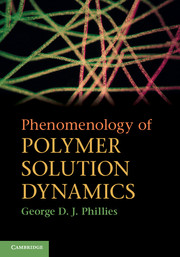Book contents
- Frontmatter
- Contents
- Preface
- 1 Introduction
- 2 Sedimentation
- 3 Electrophoresis
- 4 Quasielastic light scattering and diffusion
- 5 Solvent and small-molecule motion
- 6 Segmental diffusion
- 7 Dielectric relaxation and chain dimensions
- 8 Self- and tracer diffusion
- 9 Probe diffusion
- 10 Dynamics of colloids
- 11 The dynamic structure factor
- 12 Viscosity
- 13 Viscoelasticity
- 14 Nonlinear viscoelastic phenomena
- 15 Qualitative summary
- 16 Phenomenology
- 17 Afterword: hydrodynamic scaling model for polymer dynamics
- Index
- References
5 - Solvent and small-molecule motion
Published online by Cambridge University Press: 05 August 2012
- Frontmatter
- Contents
- Preface
- 1 Introduction
- 2 Sedimentation
- 3 Electrophoresis
- 4 Quasielastic light scattering and diffusion
- 5 Solvent and small-molecule motion
- 6 Segmental diffusion
- 7 Dielectric relaxation and chain dimensions
- 8 Self- and tracer diffusion
- 9 Probe diffusion
- 10 Dynamics of colloids
- 11 The dynamic structure factor
- 12 Viscosity
- 13 Viscoelasticity
- 14 Nonlinear viscoelastic phenomena
- 15 Qualitative summary
- 16 Phenomenology
- 17 Afterword: hydrodynamic scaling model for polymer dynamics
- Index
- References
Summary
Introduction
The next four chapters treat motion related to single polymer molecules. This chapter examines the solvent molecules surrounding the chains. Chapter 6 examines motions of modest parts of chains. Chapters 7 and 8 review rotational and translational diffusion of single chains through polymer solutions.
It had long been assumed that the solvent in a polymer solution provides a neutral hydrodynamic background, and that the properties of the solvent in a solution, such as viscosity, are the same as the properties found in the neat solvent.We know now that this simple assumption is incorrect. Just as the solvent can alter properties of the polymer, so also do polymers alter the properties of the surrounding solvent. Translational and rotational mobilities of solvent molecules may be reduced or increased by the presence of nearby polymer chains. Models for polymer dynamics that assume that the solvent has the same properties as the neat liquid are therefore unlikely to be entirely accurate.
Our focus here is the motion of small molecules in highly viscous fluids. We begin with the motion of small molecules through simple solvents and small-molecule mixtures. Molecular translation and rotation through polymer solutions are then treated. Finally, we examine high-frequency viscoelastic behavior. Important experimental techniques sensitive to these physical properties include nuclear magnetic resonance, depolarized light scattering, Mossbauer spectroscopy, nuclear resonant scattering, and oscillatory electrical birefringence.
Motion in large-viscosity simple solvents
This section examinesmotion (diffusion, conductance, electrophoreticmobility) of rigid probes through simple solvents and small-molecule solutions.
- Type
- Chapter
- Information
- Phenomenology of Polymer Solution Dynamics , pp. 94 - 115Publisher: Cambridge University PressPrint publication year: 2011



